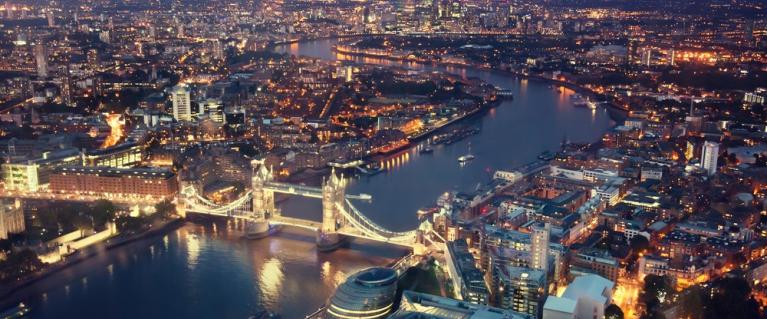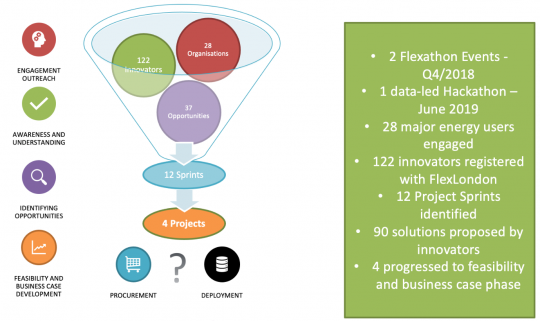
FlexLondon
FlexLondon is about helping Londoners accelerate flexible low-carbon energy, so it’s available when you need it, saving you money and reducing the city’s carbon emissions.
Between 2018 – 2020 the FlexLondon programme engaged over 150 energy users and innovators; to support commercialisation of this new flexible energy resource.
We identified organisations with the potential to use, generate and store energy at various times of the day or year, and matched them with innovators that could help manage this. Where flexibility projects didn’t materialise, we captured the reasons why, helping inform future policies and programmes.
We identified four flexible energy use cases with the potential for further replication across London which you can read more about below. By continuing to support projects like these, we can help London accommodate more renewable energy generation and manage additional demand on the grid which is being created by electric vehicles and the electrification of heat.
Supported by the Mayor of London, FlexLondon is part of his £34m Energy for Londoners programme which aims to make London’s homes warm, healthy and affordable, its workplaces more energy efficient, and to supply the capital with more local clean energy.
What is energy flexibility?
Electricity has always been produced in real time to meet users’ demands, but this is changing as we increase the amount of renewable energy we use.
The amount of electricity renewable generation produces is dependent on the wind and sunlight so, if we can use or store renewable energy when it is abundant, we can reduce the total amount of generation needed.
Flexibility is about choosing when and where we use energy, particularly electricity, to allow the entire energy system to be more cost effective for all users.
Energy flexibility is where energy users or generators can increase or decrease their demand or supply, sometimes with the use of energy storage, without affecting their normal business activities.
London has estimated it could reach up to 1GW of flexibility in 2050. If we can unlock this resource we can cut bills, improve air quality and create new sources of income by making better use of existing networks and infrastructure.
Benefits of flexibility
There is now widespread agreement about the essential role ‘demand side flexibility’ must play in supporting decarbonisation. Nationally, the UK government estimates the benefits of a smart flexible energy system to be £17- £40 billion to 2050 (or between £2.9 billion - £8 billion annually in 2030) .
The opportunity is particularly great in cities like London, where there is a high density of energy demand, and significant intersection of heat, transport and power use. Here, flexible energy use within the built environment will be increasingly essential to help decarbonise heat and transportation, as both will increase electricity demands and have the potential to be ‘shifted’ to times when carbon intensity is lowest, or to better match supply to demand.
The awareness and understanding of flexible energy amongst city actors is low however, and the city’s role in supporting new participants (such as boroughs, commercial landlords or housing associations) in the energy system through their demand-side ‘capacity’ is not well understood. FlexLondon set out to better understand and resolve these challenges, which are explored further below.
Programme summary
There were two phases to FlexLondon:
Phase one
The first phase focused on planning and engagement. We identified potential sites to provide energy, and companies that could benefit from access to flexible low-carbon energy. We engaged large energy users across nine sectors, and interviewed 18 organisations in depth. This research helped us understand the value organisations gain from becoming more flexible, the barriers to flexibility, and their interest in participating in a programme that would allow them to influence design of flexibility markets for London.
Phase two
Phase two aimed to bring together a diverse range of flexibility challenges with a pipeline of innovators to better understand how to shorten the time it takes to commercialise flexible energy services in London.
We generated several user led flexibility ‘challenges’, resulting in 12 supported ‘project sprints’ and engagement from a 100+ strong community of innovators, with the aim to deliver new flexibility by 2020. The image below highlights the number and type of organisation engaged across the programme.

Programme findings and recommendations
A detailed summary of programme findings and recommendations can be found in full via the attached slides and report.
Key findings:
• Flexibility could be the City’s greatest Energy Decarbonisation Asset
• Flexibility is complex
• Flexibility needs local solutions
• Better information is essential
Four replicable use cases were identified during FlexLondon which, if scaled, can support cost-effective decarbonisation, alongside delivering other environmental outcomes for London.
Download Flex London phase one summary findings
Download Flex London phase two summary 2021
Key Recommendations
- Conduct a study of the value of flexibility to the city
- Conduct a study to understand the full carbon value of flexibility - See Energy Unlocked's "Hidden Carbon Economy" report findings for more information
- Identify and promote use cases – To maximise opportunities for GLA programmes and London
- Open up city energy data
- Embed flexibility across the city’s zero carbon policy and delivery programmes.
London flexibility map
We used GIS mapping to help participants in the programme identify their own postcodes of interest, and map potential energy projects. Where neighbours had similar goals, this allowed synergies for project development to be found.
The following datasets were mapped in order to inform the key areas for focussing the flexibility efforts in London. The map also included a postcode search tool top enable organisations to explore the flexibility potential for their sites.
- Air Quality Focus Areas (GLA)
- Flexibility Service Areas (current challenge areas for UKPN)
- Opportunity Areas – areas for future grid developments
- EV Rapid Charging Points (RCP) – public use and taxi
- Solar PV installations – Commercial, Community & Industrial
As the programme is now complete, the map is no longer interactive. However if you require more information please email Rick Curtis (Strategy, Markets & Innovation Lead, Local Energy Accelerator): [email protected]
Find out more about the Advisory Group
Advisory group
The advisory group for FlexLondon informs project design, site identification, service provider engagement, data requirements, accelerating projects and flexibility market design.
Phase 1
Mark Thompson, Energy team, Innovate UK
David Shipworth, Professor of Energy and the Built Environment, UCL Energy Institute
Shelagh Whitley, Climate and Energy Lead, Overseas Development Institute
James Byrne, Co-Founder, Sustainable Workspaces, and Better Futures Delivery Partner
Nick Mabey, London Sustainable Development Commission and co-Founder, E3G
Paul Jordan, Head of Business Development, Energy Systems Catapult
Tim Pryce, Energy and Buildings Programme Director, C40
Phase 2
Tereza Borges, co-Founder, N3rgy
Sotiris Georgiopoulos, Head of Smart Grid Development, UK Power Networks
Ian Walker, Director, Element Energy
David Merefield, Senior Energy and Carbon Manager, Sainsbury’s
Emma Harrison, Head of Systems Integration, Energy Systems Catapult
Tim Stiven, Head of Delivery, Energy Systems Catapult
Tanja Dalle-Muenchmeyer, Programme Manager Electric Freight, Cross River Partnership
Manu Ravishankar, Manager, Policy and Innovation, The Carbon Trust
Andrew Lever, Director, Policy & Innovation, The Carbon Trust
Benjamin Kott, CEO, Fabriq
Sally Fenton, Project Leader, UK Department for Business, Energy and Industrial Strategy (BEIS)
Dr. Jeff Hardy, Senior Research Fellow, Imperial College London
Jonathan Bryers, Partner, 350 Investment Partners
Marie-Christine Napier, IMCG Innovation, and Project Manager for CELSIUS (Horizon 2020)
Need a document on this page in an accessible format?
If you use assistive technology (such as a screen reader) and need a version of a PDF or other document on this page in a more accessible format, please get in touch via our online form and tell us which format you need.
It will also help us if you tell us which assistive technology you use. We’ll consider your request and get back to you in 5 working days.